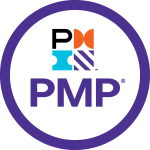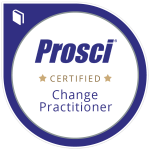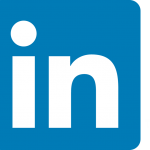
Do you feel like you are in too many meetings? You are not alone.
Whether you are a leader needing to inform your organization about the transformation plan, a facilitator grinding with a cross-functional group to collaborate on an innovative go-to-market process, or a planner tasked to drive prioritization and decide on a quarterly replan, you rely on getting a number of willing (and sometimes unwilling) participants together to work toward agreed upon meeting outcomes leading to business results. As the bias towards more meetings increases, along with associated concerns, this significant resource expenditure needs to be managed as any other core business process.
Bad meetings don’t have to be a way of life4
The most common improvement opportunities we observe with our clients, across-the-board, are improvement in communications and in meetings. In the following, we are going to focus on both the quantity and quality of meetings, as we have addressed the importance of communication in a previous post.
While there are literally thousands of articles focusing on a very specific issue or one particular component of meetings, we will focus on helping you think holistically about most types of meetings- the 20% of content covering the 80% of situations. In order to simplify one of business’ most common tool, we will share our points of view around 1) the contextual stages of a meeting, while thinking of meetings as a process and 2) using four management principles to support the meeting process. With a focus on these themes, we believe you will be able to optimize the quality and number of meetings. And, you will begin to be able to manage meetings as you manage processes based on results and cost. Perhaps you will even apply some of your well-worn techniques for continuous improvement.
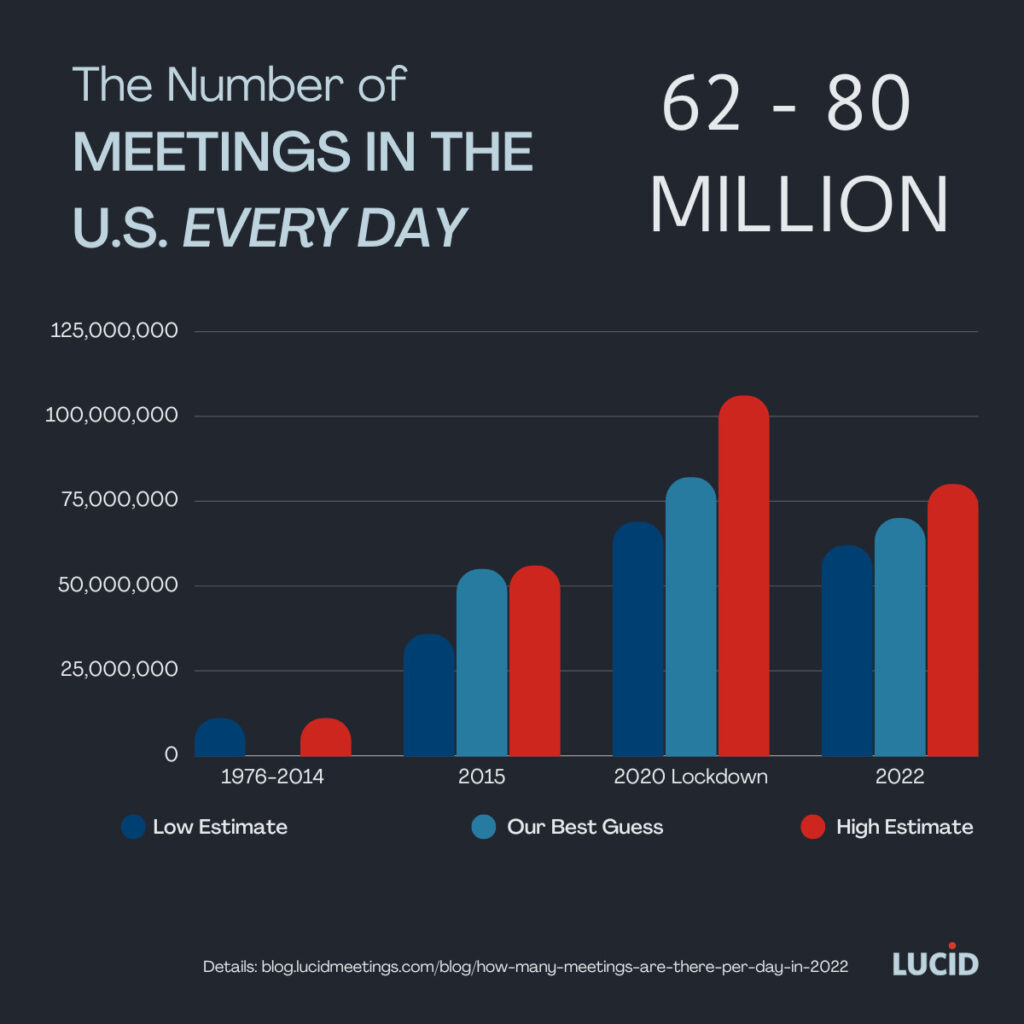
Figure 1 | No. of US Meetings everyday
Source: Lucid Meetings Blog
Long-term Trend of Meetings
Lucid, an organization focused on meeting innovation, estimates at least 60 million meetings every day in the U.S.1 and 2022’s estimate caps a trend
- 1976: 11 million
- 2015: 55 million
- 2020 lockdown: 80+ million
- 2022: 62 to 80 million
Typical Meeting Concerns
Senior managers across a number of industries believe meetings2…
- keep them from completing their own work (65%)
- are unproductive and inefficient (71%)
- come at the expense of deep thinking (64%)
Meeting research3 also stacks up against meetings as:
- unproductive time (30-50% of meeting hours)
- time to do other work (admitted by 73%)
- time to daydream (admitted by 90%)
- run by “untrained” leaders (only 20% are trained)
Meetings are a cost to be managed, just like any other core process
Consider a weekly standing meeting of say six employees, each at $60/hour (e.g., assuming an average employee’s unloaded cost of $120K/year). With some quick math, 6 employees at $60/hour for 50 weeks = $18K each year. If we invite 4 more employees to the meeting, do we get $12K increase in productivity?
The illustration above is for one meeting. How many weekly standing meetings do you have in your department, your division, and your organization as a whole? What share of total labor cost is associated with meetings, especially for office-based employees? For an even better assessment, add in the opportunity cost of what these people should, or could, be doing if they were not sitting in meetings. Ultimately consider the value for all recurring and overlapping meetings across your organization.
What is a meeting?
If we start to unpack Wikipedia’s definition, a meeting is a “gathering of two or more people that has been convened for the purpose of achieving a common goal through verbal interaction.5” We immediately see a few basic characteristics. A meeting…
- Focuses on a common goal
- Involves some number of people, in real-time
And yet, one of the most common issues we hear about and observe are inefficient meetings with unclear outcomes. With unclear outcomes or key results6, is it surprising we end up with the wrong people, or too many people, in the room? Often we find that meetings are implemented as a “quick fix” to underlying problems in routine business processes.
Before we get too far into definitions, processes and principles. Let’s set our guiding star, our precept, our procedural rule…
We only put as much structure and management into a meeting (and its process), as is required to efficiently manage and avoid failure
That said, let’s start by simplifying the lifecycle of a meeting- from initial decision to “have a meeting” through to business results. We have broken the meeting lifecycle into four stages. (See Figure 2)
At a high-level, a meeting process considers the stages and steps you go through to plan, execute and follow-up on the work accomplished during the meeting. We also incorporate a decision framework for you to consider the implications of the types of outcomes (e.g., inform, collaborate and decide) and number of participants (e.g., discrete group, working group, and venue-limited) (See Figure 4). We will begin with the meeting process (See Figure 5) and end with some thoughts on remote meetings.
MEETING AS A PROCESS
Start with the “Why?”
Results! Every meeting should begin with a crystal-clear focus on the endpoint, and how, with follow-up, meeting deliverables and outcomes will create key results for the organization.
Consider how most people enter a meeting with disparate and competing needs. We think about this as the “paradox of meetings.” We want to increase communication from, and to, meeting participants. While at the same time, we want to reduce meetings, because, if not well considered and composed, can be incredibly inefficient. Having a common language of Meeting as a Process including, clarity of results, for example, can be a foundational start.
Some of what we are NOT addressing in this post
While we believe there are opportunities for improvement, this post focuses on the 80% of the business meetings we are all familiar with: The standing daily, weekly, monthly meeting, the “Why am I here?” meeting…
- We are not focused specifically on team meetings
- We are not defining facilitation beyond its importance in creating a Supporting Environment. Certainly, facilitation is critical to achieving results in certain types of team meetings, and there are plenty of books on our and your bookshelves to cover facilitation.
We are not advocating for meetings to share status, except in special cases, as we believe status can be best handled with an asynchronous consent agenda7.

Figure No. 2 | Outline of Meeting Lifecycle in 4 stages
Four stages of a Meeting as a Process thinking
At a high-level, a meeting process considers the stages and steps you go through to plan, execute and follow-up on the work accomplished during the meeting. We also incorporate a decision framework (see Figure No. 4) for you to consider the implications of the types of outcomes (e.g., inform, collaborate and decide) and number of participants (e.g., discrete group, working group, and venue-limited). We will begin with the meeting process and end with some thoughts on remote meetings.
Stage 1: Microassessment
Consider: Do we need a meeting8? What are the alternatives to a meeting?
For example, can we achieve our results through email, through video to inform, through comments on a draft brief, or through asynchronous voting to decide? Is it worth the cost? What are the risks? Do we need a business case? Are we proposing a meeting because of a failure in the normal work process?
The Microassessment9 can be as informal or formal as you need to manage the tradeoff of the cost of having the meeting versus the risk of not having a meeting, but should be informed by our guiding star (e.g., a reminder… We only put as much structure and management into a meeting (and its process), as is required to efficiently manage and avoid failure). Alternatives may range from an informal mental check list or qualitative read on achieving results, up to a formal business case including cost/benefit analysis- particularly for large, geographically distributed set of participants in a multi-day event composed of multiple breakout-meetings.
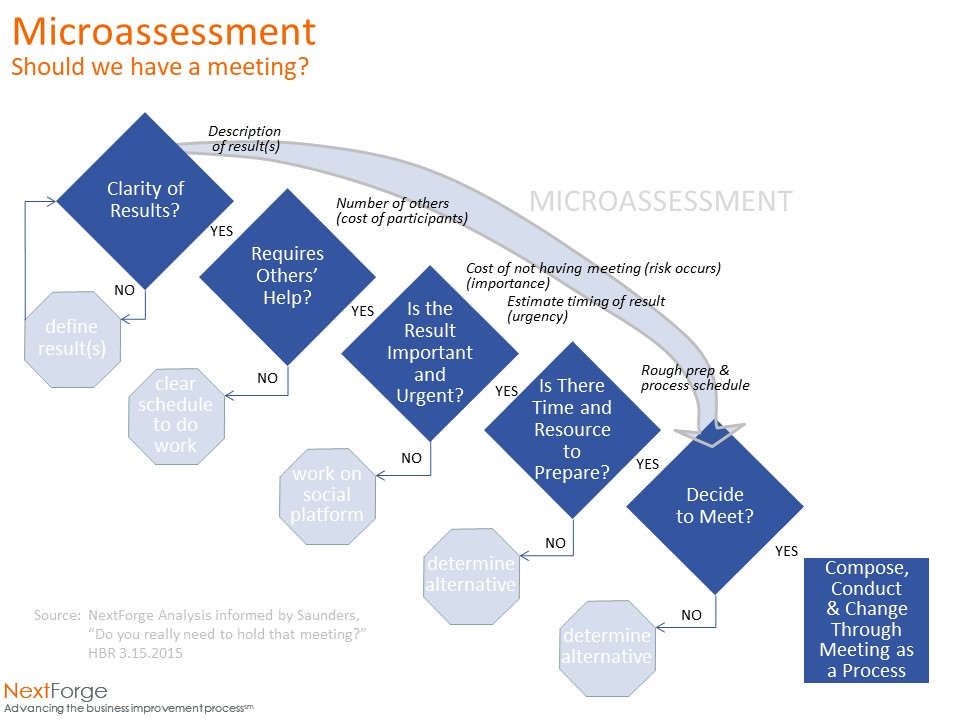
Figure No. 3 | Decision thread for considering whether to have a meeting or not
We feel this idea of a microassessment is rarely, if ever, considered. But, if you think of meetings as a process, there are many ways to continuously improve the meeting process. Starting with more often considering the underlying need/benefits of a meeting.
However, if we do need a meeting, our next stage is to consider what type of meeting do we need to be thinking about, based on meeting outcomes and expected post-meeting organizational results impacting the business.
Stage 2: What type of meeting do we need?
With focus on results, consider “how many” and “who” should attend a meeting to produce one of three meeting outcomes in our perpetual chase for better business results.
- Inform
Sharing information through one-way or two-way communication to achieve results from engagement, alignment, training, building relationships, and one-on-one development - Collaborate
Work jointly to solve problems or create a deliverable - Decide
Come to a conclusion after consideration of a defined topic10
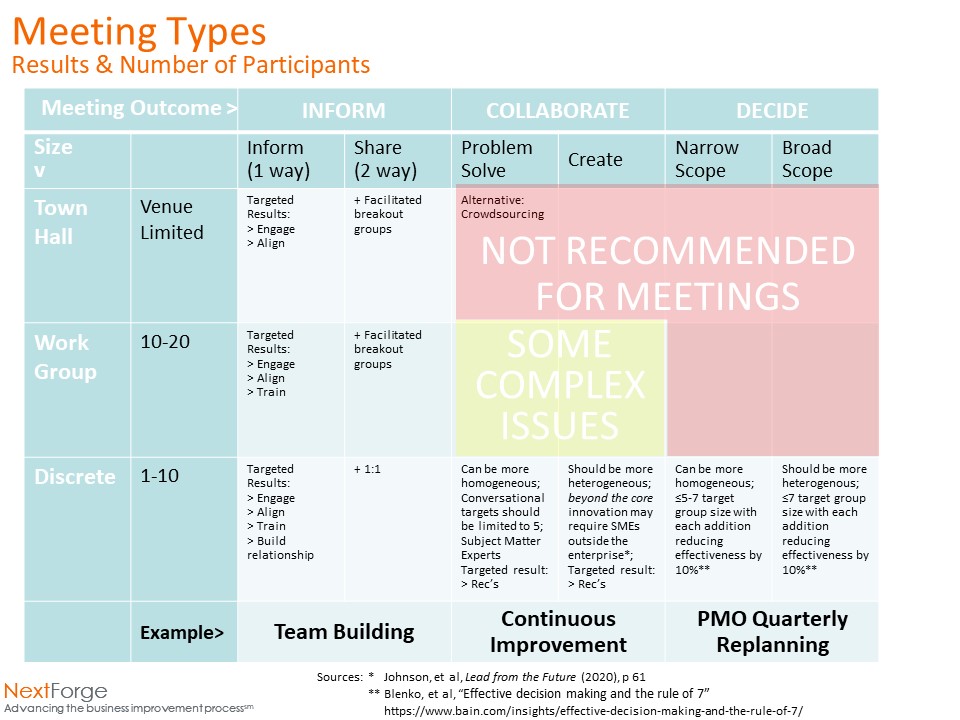
Figure No. 4 | Worksheet illustrating key dimensions of each meeting result-type
On the people side of meetings, we believe there are some natural breaks in group-size for each meeting type. For example, one key research thumb-rule based on Bain’s research and work with clients defines having 7 or less people in a decisioning meeting11.
Use the Figure No. 4 Worksheet to help you consider the profile of your meeting based on meeting results-driven outcomes. Specific types (e.g., Inform, Collaborate, Decide) and targeted knock-on results, will be best accomplished by a specific group size.
With an optimal meeting type identified, we are now ready to move to the stage focused on the work of the meeting through a common process.
Stage 3: Common Process
Because of all the one-off solutions and the breadth of meaning of “meeting,” the common process defines the elements common to most meetings. We believe the common process, the activity of creation to all meeting can be defined as: the “3Cs”: Compose, Conduct and Change (See Common Process, Figure 5)
- Compose: All work before the meeting by the owner, facilitator and participants
- Conduct: All work within the meeting to achieve objectives and targeted meeting outcomes.
- Change: All post-meeting work required to convert meeting outcomes into business results
If we push to some basic definitions of the Common Process (e.g., more detail and structure for most meetings) and its 7 descriptive activities: Assess & Prepare (setting expectations and prework); Open (prepare for the meeting journey), Focus (Do work), Plan (Define post-meeting steps); and Operationalize [Meeting] Outcomes (post meeting follow-up) and Achieve Results (post-meeting plan execution).
We have also defined in the following draft a Tactics “Checklist” of sorts to inform some of the activities and key steps which would be considered in Common Process work. This Tactics Checklist should be refined by meeting type, your organization’s culture, and the specifics of your meeting design.
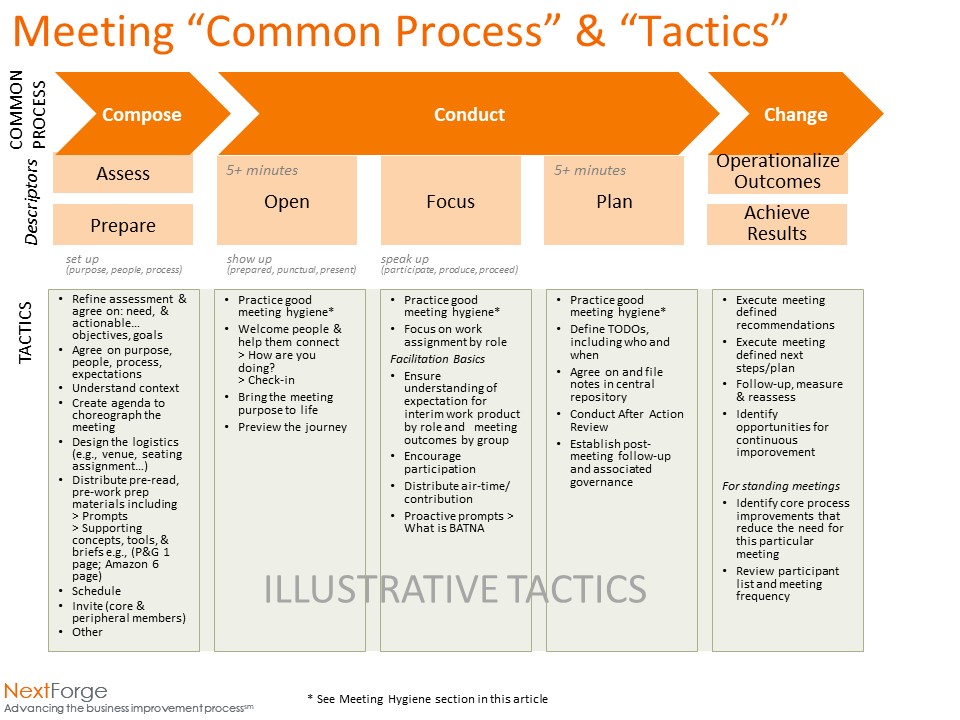
Figure No. 5 | A worksheet defining the common meeting process
One of the key benefits of a common process is the ability to engage process management and improvement capabilities for both more efficient and effective meetings as measured by business results.
Stage 4: Key Results
Not only should we be constantly thinking about “Why are we here?” outcomes during the meeting, we should be focused on “How we are going to achieve the key result(s)” informed by our work and outputs/deliverables, including next steps (e.g., a post-meeting plan), to achieve impactful, Key Results (e.g., Balanced Scorecard performance measures: financial, customer, internal, innovation and/or learning12).
For recurring meetings, are there changes to work processes and/or their execution that could eliminate the need for a meeting altogether?
Beyond the lifecycle stages and common process of meetings, there are key principles which define some process basics (e.g., inputs/outputs, meeting steps) and some contextual and meeting specific attributes (e.g., supporting environment, modality) required to make your Meeting as a Process capability drive organizational performance.
KEY PRINCIPLES13 FOR SUCCESSFUL MEETINGS
So, how do you manage the Meeting as a Process for improved results? You can start with the following attributes.

Figure No. 6 | Outline of 4 key principles supporting the Meeting Lifecycle
Principle: Inputs & Outputs
Just like a process, you should have clear inputs and outputs for the various meeting steps. These inputs and outputs to each meeting step should collectively reflect the expectations of the meeting as developed during the Compose stage of the meeting Common Process architecture.
Be sure to sharpen your focus on your inputs and outputs throughout the lifecycle of your meeting. Specifically, start with a crystal-clear alignment on your meeting outcomes and expected post-meeting key results. Picking the meeting type, the second meeting lifecycle stage, requires consideration of the number and specific individuals who should be included to do the work during the focus step of the Common Process to achieve the key results (Inform, Collaborate or Decide) your meeting needs to achieve. Looking to process basics, like stage-gated milestones14, may help here too.
Other inputs considered during Assess and Prepare include, for example, ensuring enough time for participants to prepare15, supporting data and analysis, common assumptions, and relevant decision criteria.
Principle: Supporting Environment
The most common support for your meeting environment is typically referred to as Meeting Hygiene.
Meeting Hygiene (a few starter lists)
In a LinkedIn post, Liz Evenden posited four “Hygiene Factors” for meeting hygiene16. She shares: “they are obvious, but they’re not effort-free. They’ll need a little energy and focus to initiate.17” So, let’s start with Ms. Evenden’s Factors.
- Factor 1: Start and finish on time
- Factor 2: Have an agenda18 *
- Factor 3: Have a skilled person in charge **
- Factor 4: Remove distractions
Empathetic Leader19
- Asks rather than tells
- Listens rather than speaks
- Serves rather than commands
- Cares about people’ concerns
- Is receptive to feedback
- Does not overact to people’s questions or concerns
- Does not interpret concerns as resistance
Looking for more a detailed set of hygiene factors? Billionaire founders typically have a POV on many topics, and meetings appear to be one of them. Here are two billionaire-founder’s thoughts:
Eight rules for running a great meeting20
Eric Schmidt, Google
- Every meeting needs a leader **
- The meeting needs a clear purpose and structure *
- Meetings used for sharing information or brainstorming still need owners
- Have a meeting only if it’s necessary
- Don’t include more than 8 people
- Include only the necessary people and no more
- Strictly follow time constraints
- Be fully present in the meeting
* ** Indicates a common recommendation among all three examples
If it is your meeting to run, manage the conversation21
Ray Dalio, Bridgewater Associates
- Make it clear who is directing the meeting and whom is the meeting meant to serve **
- Be precise in what you are talking about to avoid confusion *
- Make clear what type of communication you are going to have in light of the objectives and priorities
- Lead the discussion by being assertive and open minded
- Navigate between the different levels of the conversation
- Watch out for topic slip
- Enforce the logic of conversations
- Be careful not to lose personal responsibility via group decision making
- Utilize the “two-minute rule” to avoid persistent interruptions
- Watch out for assertive “fast talkers”
- Achieve completion in conversations
- Leverage your communication
Notice above, we only found two common recommendations out of lists of 4, 8 and 12 from those who are experts in running meetings.
Based on our experience, here are a few more components of meeting hygiene to consider
- Participant meeting roles
Not every meeting needs every role tightly defined, and an individual participant can hold multiple roles (e.g., facilitator and scribe)
- Leader
- Facilitator22
- Timekeeper
- Scribe
- Participant
- SME
- NO GAWKERS (It is critical to limit your meetings to proactive, productive contributors)
- Meeting notes
- Capture key themes/decisions; summarize in bullet points
- Sequence next steps, including who and when
- Behavioral ground rules: culturally-driven with best-practice aspirations
- Self-filtering participation
- Complement and build
- Check your phones at the door
- Self-opt-out (abstention), participants see as low/no value add (nullification)
- Parking lot to list important topics to be covered at a different time
- Start on time23
- Why Am I Talking? (“WAIT”)
- For every hour of meeting, plan on 10 minutes of non-work activities (a design thumb-rule)
- Meeting length24
Again, considering our guiding star25, it will be critical for you to consider what meeting hygiene is necessary for your meeting type, your team, your culture, and your preferences.
Psychological Safety
In order for your primary participants to engage and participate, you must ensure a psychologically safe environment26 that will support engagement, sharing of information, sharing of ideas, and, most importantly, sharing of a portion of each participant’s brainpower to help achieve meeting outcomes.
Other Techniques (Meeting “How To” resources)
On the internet, in articles and in published books, you can find thousands of recommendations on the “how to” run, facilitate, and manage meetings. We encourage you to create and internally publish a custom set of elements which create an appropriate, supportive environment for your organization.
A supportive environment should include the basics shared above (e.g., Hygiene, Psychological Safety and other techniques) as customized by you and your organization through a learning environment. We spent the most time on meeting hygiene, as it provides the most support for the heavy lifting during the meeting. One of the best tools to aid learning on “what is best” within processes, projects and meetings is an After Action Review (AAR). Do you regularly conduct after meeting assessments of some type? You should! AARs will help build and refine a common meeting process.
Principle: Meeting Steps
As we look at each of the 3 Common Process steps (3C’s) of Compose, Conduct, and Change (e.g., Assess & Prepare; Open, Focus, Plan; Operationalize Outcomes & Achieve Results), we can see how the Process Tactics (e.g., Assess and agree on need and actionable [meeting] objectives, goals; Practice Good Meeting Hygiene; Welcome People and Help Them Connect; etc.) inform the Meeting Steps. And, we can see the Tactics as a starter list relevant to most, but not all, meetings.
It is up to you and your organization to develop the best Tactics Checklist for your organization and your specific needs. Please consider this Illustration of tactics and prompts when developing your starter-list.
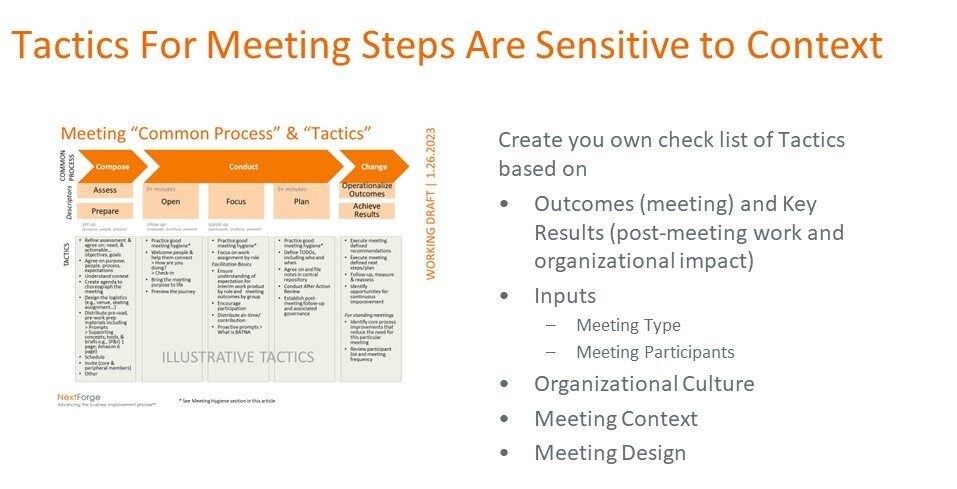
Figure No. 7 | Reinforcement of the roles and relevance of Common Process Tactics
Principle: Modality Matters
According to Hooijber and Watkins, “hybrid work means team interactions in which some meetings are in person and other are virtual, but everyone is participating in the same ‘mode.’”27 Hooijber and Watkins are talking about the new reality most organizations are wrestling with- namely, how much face-to-face and how much remote participation is optimal.
Our experience managing mixed mode-meetings seems to align with research findings- mixed-mode meetings are the least desirable meeting type (e.g., a combination of face-to-face and remote participants). Hooijber and Watkins also weighed in how mixed-mode meetings raise “the risk of creating two tiers of participation, access and influence.28” In short, the authors found four tests. Passing the tests is required to support the use of mixed-mode meetings over, for example, all remote and the gold-standard of all in-person meeting. (We have restated the four options in the following list for clarity)
- If the group has a strong foundation of trust and connection
- If the mixed-mode would create business value
- If the remote participants can present as a “powerful presence”
- In the meeting can build informal connection between the in-person and the remote participants29
Meeting as a Process | A worksheet
The following worksheet, including prompts, can be a helpful focusing mechanism to support your consideration of the 3C’s of the high-level Common Process (e.g., Compose, Conduct and Change). The Meeting as a Process should be considered throughout the stages of the meeting lifecycle to achieve not only meeting-objectives-driven outcomes, but also the ultimate driver of the expected business results.
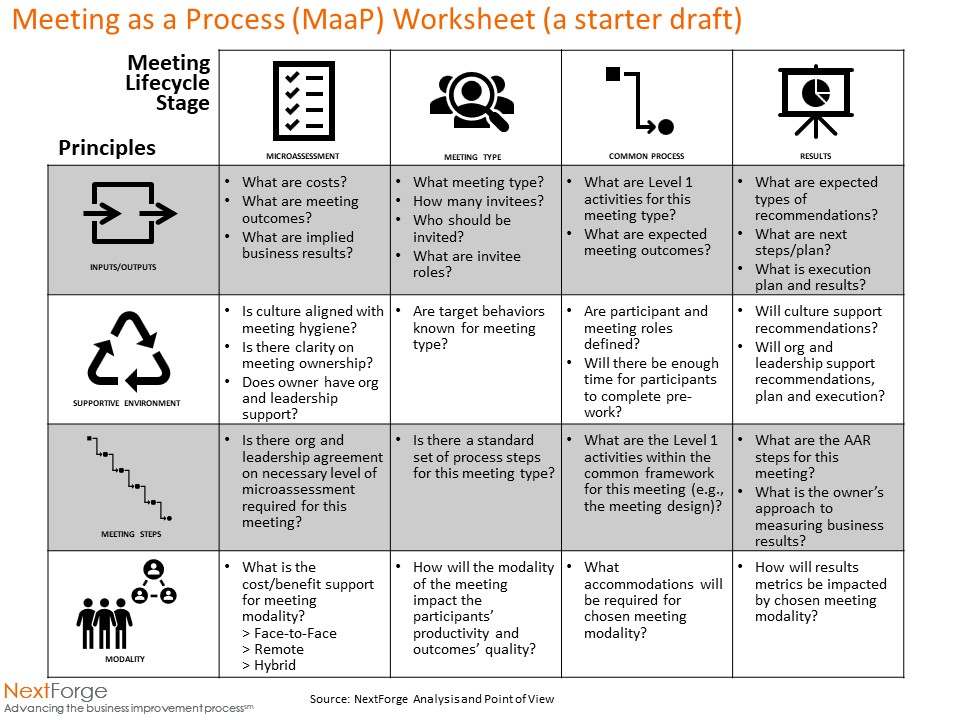
Figure No. 8 | Worksheet with prompts to consider the Principles role by Lifecycle Stage
A FEW CLOSING THOUGHTS ON MEETINGS
“Innovation isn’t always a planned activity”
Tim Cook, CEO Apple30
Trevor and Holweg in a recent MITSloan Management Review article identified 2 out of 4 categories (e.g., coordinated group tasks and collaborative creative tasks) where a high level of human interaction is required31. In short, we will continue to need meetings for certain tasks.
Interestingly Laker, et al32, showed the impact of meeting-free days along 8 individual [performance] dimensions based on their research of 76 companies with more than 1,000 employees each. Their findings covered between 1 and 5 meeting-free days a week. Laker, et al, found 3 meeting-free days a week was optimal, where employee ratings showed: Productivity improvement reported up by 73%, Communication reported improved by 61%, and Employee Satisfaction was reported improved by 65%. Not surprisingly the Laker, et al, article on meeting free days was the second most widely read MITSloan Management Review article for 202233, demonstrating the keen interest most of us have in meetings and meeting management.
We believe managing Meetings as a Process allows you not only to look at effectiveness, but also the efficiency (e.g., direct cost of buns-in-seats and opportunity costs) of Meetings as a Process thinking. From this perspective, one organizational challenge relates to the question of whether or not to have a meeting: should the default answer be “YES” or “NO”?
Any ideas how you can improve your organization’s approach to meetings? Please join the discussion…
End Notes
- See Elise Keith, “How many meetings are there per day in 2022? (And should you care?)” Published Aug 31, 2022, [internet] [cited Jan 19, 2023] Available from https://blog.lucidmeetings.com/blog/how-many-meetings-are-there-per-day-in-2022
- See Perlow, et al, “Stop the meeting madness,” Harvard Business Review. Jul-Aug 2017 “We surveyed 182 Senior managers across a number of industries…”
- See Rogelberg, “Why meetings go bad (and how to fix them),” Ideacast, Nov 5, 2019 [internet] [cited Jan 19, 2023] Available from https://hbr.org/podcast/2019/11/why-meetings-go-wrong-and-how-to-fix-them
Also see Rogelberg’s The Surprising Science of Meetings, NY, NY: Oxford University Press (2019), which informed our thinking along with Professor Rogelberg’s cited and not cited podcasts. Specifically focus on “Meeting Recommendations” pp 141-147 and “Tools” pp 149-165 - See Rogelberg, “Why meetings go bad (and how to fix them),” Ideacast, Nov 5, 2019 [internet] [cited Jan 19, 2023] Available from https://hbr.org/podcast/2019/11/why-meetings-go-wrong-and-how-to-fix-them
- See “’Meeting’ a definition” Wikipedia, [internet] [cited Jan 19, 2023] Available from https://en.wikipedia.org/wiki/Meeting
- We are adding a bit of precision through word choice here, more than might be initially obvious. We are suggesting “key results” in lieu of goals or objectives. There is a large following, including your author, who believe there is power in simplicity of planning. We advocate for Doerr’s OKRs as he defined in Measure What Matters (2018) where Objectives are directional “what” and less specific than the “how” to achieve those objectives through the “metrics” and “targets” of “Key Results.” And, while we are stretching a bit to apply a longer-term planning concept to meetings, we believe the focus on meeting outcomes and organizational results in support of operations and strategy is central to successful meetings
- Consent agenda we are most familiar with typically includes a short (less than one page) note on status (e.g., activity/progress since last meeting, issues or problems the individual would like feedback on or help solving and is reviewed by participants as prep for a standing/progress meeting)
- See Sanders, “Do you really need to hold that meeting?” Harvard Business Review, Mar 20, 2015 [internet] [cited Jan 19, 2023] Available from https://hbr.org/2015/03/do-you-really-need-to-hold-that-meeting
- Microassessment could include consideration of alternatives (e.g., non-meeting publish, comment, decide; a process; a project; business as usual) and a decision (e.g, hold a meeting or NOT hold a meeting) . Other considerations for the Microassessment include high-level requirements, inputs and outputs, business case worksheet, etc.
- See Dalio, Principles, NY, NY: Simon & Schuster (2017) “decision making is a two step process: first take in all the relevant information, then decide,” p 188
- See Blenko, et al, “Effective decision making and the rule of 7,” Bain.com, Sep 28, 2010 [internet] [cited Jan 19, 2023] Available from https://www.bain.com/insights/effective-decision-making-and-the-rule-of-7/
- See Kaplan and Norton, “The Balanced Scorecard- Measures that drive performance,” Harvard Business Review, Jan-Feb 1992
- See Dalio, Principles, NY, NY: Simon & Schuster (2017) “Principles are fundamental truths that serve as the foundations for behavior…” p ix
- See Gupta, et al, “Make milestones mater with ‘decision gates,’ stage gates with real teeth,” McKinsey & Company Operations Extra Net, Jun 2017 [internet] [cited Jan 19, 2023] https://www.mckinsey.com/capabilities/operations/our-insights/make-milestones-matter-with-decision-gatesstage-gates-with-real-teeth Using a product development project as an example, McKinsey discussed gating product stages, just as we would consider gating (e.g., GO/NO GO) a Meeting as a Process decision for some types of meetings which, for example, require specific inputs and outputs to be successful
- See Umoh, “Why And How Every Company Should Use Amazon’s Six-Page Memo Format,” CNBC, Apr 23, 2018 [internet] [cited Jan 19, 2023] Available from https://www.cnbc.com/2018/04/23/what-jeff-bezos-learned-from-requiring-6-page-memos-at-amazon.html Bezos is quoted in the article “‘Amazonians’ create six-page narrative memos that are read at the beginning of each meeting—kind of like a ‘study hall,'” and, Bezos continues, “[The memo is] supposed to create the context for what will then be a good discussion.”
Also see Ladd, “Why And How Every Company Should Use Amazon’s Six-Page Memo Format” Forbes Aug 30, 2022 [internet] [cited Jan 19, 2023] Available from https://www.forbes.com/sites/forbescommunicationscouncil/2022/08/30/why-and-how-every-company-should-use-amazons-six-page-memo-format/?sh=3c236430311e “Instead of using PowerPoint, Amazon executives sit around a table and read six-page memos in silence. This strategy allows a company’s executives to discuss the idea and review the details after reading the memo” - See Evenden, “Meeting Hygiene- Clean up you act!,” LinkedIn, Mar 17, 2019 [internet] [cited Jan 19, 2023] Available from https://www.linkedin.com/pulse/meeting-hygiene-clean-up-your-act-liz-evenden/
- See Evenden, “Meeting Hygiene- Clean up you act!,” LinkedIn, Mar 17, 2019 [internet] [cited Jan 19, 2023] Available from https://www.linkedin.com/pulse/meeting-hygiene-clean-up-your-act-liz-evenden/
- See Rogelberg, et al, “How to create the perfect meeting agenda,” Harvard Business Review, Feb 26, 2020 “Research has actually found little to no relationship between the presence of an agenda and attendee’s evaluation of meeting quality”
- See Conley, “Leading with Empathy,” Leaderchat.org, Apr 7, 2022 [internet] [cited Jan 19, 2023] Available from https://leaderchat.org/2022/04/07/leading-with-empathy/
- See Feloni, “Google Chair Eric Schmidt’s 8 Rules for Running a Great Meeting” BusinesInsider.com, Sep 2014 [internet] [cited Jan 19, 2023] Available from https://www.businessinsider.com/googles-rules-for-a-great-meeting-2014-9
- See Dalio, Principles, NY, NY: Simon & Schuster (2017) “4.4 If it is your meeting to run, manage the conversation,” pp 365-368
- While we defer to the wide body of knowledge published on facilitation, a couple of examples do come to mind
> Ensuring engagement of all participants through for example, “calling” on meeting participants
> Quiet time to capture thoughts on a facilitated prompt, followed by round-robin readout - The behavioral rule of timeousness is particularly critical to remote meeting to minimize “popcorn popping” effect of late-entry notices
- We have seen an uptick in the number of organizations that have moved to define an organization standard of 25-30 minute meeting, with the intent to bring more focus and efficiency to meetings. This shorter meeting time can be complemented by enterprise-wide platforms for pre-read, post-edit and other meeting-adjacent one-way communication of information
- Recall our Guiding Star statement at the top of the post: “We only put as much structure and management into a meeting (and its process), as is required to manage the risk of failure”
- From Amy Edmondson’s personal website: Psychological Safety is… “a belief that one will not be punished or humiliated for speaking up with ideas, questions, or mistakes, and that the team is same for interpersonal risk-taking,” [internet], [cited Jan 19, 2023] Available from https://amycedmondson.com/psychological-safety/. Amy Edmonson is a Harvard Business School professor who coined the term “Psychological Safety”
- See Hooijber and Watkins, ”When does it make sense to have mixed-mode meetings?” MIT Sloan Management Review, Aug 25, 2021 [internet], [cited Jan 19, 2023] Available from https://sloanreview.mit.edu/article/when-does-it-make-sense-to-have-mixed-mode-meetings/
- See Hooijber and Watkins, ”When does it make sense to have mixed-mode meetings?” MIT Sloan Management Review, Aug 25, 2021 [internet], [cited Jan 19, 2023] Available from https://sloanreview.mit.edu/article/when-does-it-make-sense-to-have-mixed-mode-meetings/
- See Hooijber and Watkins, ”When does it make sense to have mixed-mode meetings?” MIT Sloan Management Review, Aug 25, 2021 [internet], [cited Jan 19, 2023] Available from https://sloanreview.mit.edu/article/when-does-it-make-sense-to-have-mixed-mode-meetings/
- See Trevor & Holweg, “Manage the New Tensions of Hybrid Work” MIT Sloan Management Review, Winter 2023. Focused on the future of work, this is a citation for Tim Cook quote
- See Trevor & Holweg, “Manage the New Tensions of Hybrid Work” MIT Sloan Management Review, Winter 2023. The four categories of individual tasks include: individual procedural tasks; focused creative tasks; coordinated group tasks; and collaborative creative tasks with the later 2 requiring social, human interaction to be completed
- See Laker, et al, “The Surprising Impact of Meeting-Free Days” MIT Sloan Management Review, Jan 18, 2021. [internet] [cited Jan 19, 2023] Available from https://sloanreview.mit.edu/article/the-surprising-impact-of-meeting-free-days/
- See MacDonald, “The Top MIT SMR Articles of 2022”, MIT Sloan Management Review, Dec 21, 2022 [internet] [cited Jan 19, 2023] Available from https://sloanreview.mit.edu/article/the-top-mit-smr-articles-of-2022/ Most widely read articles, of which “The Surprising Impact of Meeting-Free Days” was ranked number second most popular for 2022.


